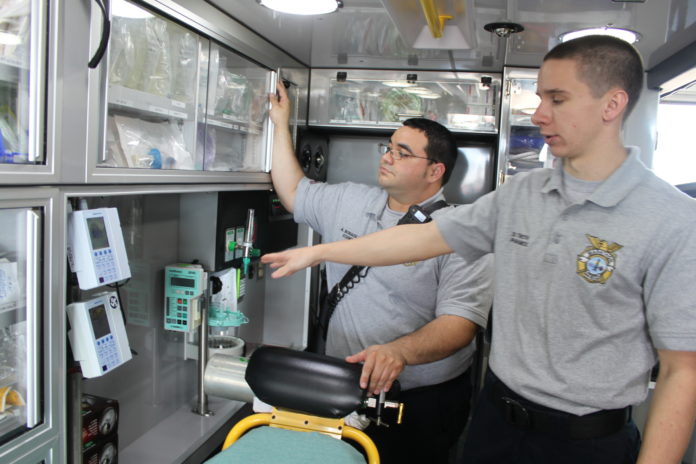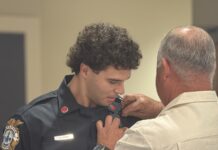
Late on Easter Sunday, a rescue ambulance from City of Marathon nudged its way through northbound traffic on the 18-Mile Stretch at about 8 p.m. Aboard was a young child headed for Miami Children’s Hospital under the watch of critical care paramedic Alexander Bombadilla and Critical Care Division Chief Capt. Joe Forcine.
All told, the two men spent more than seven hours on the transport — about a half hour on the scene, three hours en route, another hour at the hospital, and another three hours home again to Marathon.
“The crew has been doing a great job. Many of our paramedics have stepped up for additional training to become qualified for the inter-facility transports,” said Marathon Fire Rescue Chief John Johnson. “They’ve embraced it for all the right reasons — to protect our residents.”
The number of inter-facility transports — from Fishermen’s Hospital in Marathon to Mariners Hospital in Tavernier, or a mainland facility — is way up. As the Middle Keys hospital transitions from a field hospital to a modular, temporary hospital and then a brand new facility, that trend is likely to continue, as services are limited. So much so, that the City of Marathon Fire Rescue has been approved for another type of service called a “two-tier response.”
“What that does is allow us to bypass the stop at Fishermen’s Hospital if we know the patient needs advanced care not currently available in Marathon,” said Forcine. “For example, if someone has a neck injury and needs an MRI, the patient would go directly to another hospital, in the Upper Keys or on the mainland.”
Before Hurricane Irma and the subsequent damage to Fishermen’s Hospital, the City of Marathon typically moved about 30 patients per month from one facility to another. That number now is usually between 70 and 90 a month. The calls to 9-1-1 are also up — in March of 2017 there were 203 calls; last month there were 352.
Currently, there is no plan to add more paramedic staff.
“We don’t know how long that’s going to last,” said Johnson. “Those calls may go back down (when the hospital reopens).”
According to Forcine, the City of Marathon has a good collection rate for these services. The city bills the appropriate insurance company for transport.
“We recoup somewhere between one-third to one-half of our costs,” he said.
In 2017, Marathon’s EMS service billed about $741,000 and collected $516,000. Another $200,000 is in “active collection,” such as those patients who are making monthly repayment. There is about $2 million in uncollected fees for services rendered in the last 10 years; some of that is when an insurance company only reimburses part of the charge.
Marathon’s ambulance fees range from $449 for basic life support all the way up to $852 for Advanced Life Support (ALS) critical care, plus a charge of $10.90 per mile. If it’s an inter-facility transport, Baptist Health South Florida guarantees payment based on a pre-approved rate schedule — $256 for basic life support up to $380 for ALS runs, plus $7.50 per mile.
“This has helped us to be able to offset costs,” said Johnson.
The city’s Fire Rescue annual operating budget is $3.6 million. It collects $1.2 million annually from the City of Key Colony Beach for services, $500,000 from its own EMS collections, $170,000 from fire inspection fees, and $6,600 from the state.
Currently, the city runs five trucks — two Advanced Life Support (ALS) trucks that typically respond to 9-1-1 calls and two critical care vans, which are usually used for transports. In addition, it has a fully equipped ALS fire truck that can also respond. On any given day, there are 10 crew members at work. The critical care vans are stocked with an impressive array of medication and equipment — much more comprehensive than is typical. For example, it has ventilators, IV pumps and stocks 76 different types of medication.
“The City of Marathon’s fire trucks deliver as many drugs as do big city rescue operations,” said Mike Leonard, chairman of the Fishermen’s Hospital Council of Baptist Health Foundation. “I am absolutely blown away by what Chief John Johnson has done with fire rescue in Marathon. He’s an incredible leader.”
“The only thing we don’t have is an X-ray machine or a ‘Istat’ device,” said Dennis Timothy, a lead medic on the critical care van in Marathon. The Istat is a hand-held device that can deliver lab results — blood gases, glucose and cardiac markers — in two minutes. The device costs about $10,000 and Forcine hopes it can be acquired quickly.
“Another thing we need is a hand-held ultrasound machine,” Forcine said. “After a car accident, for example, when someone is complaining of abdominal pain we could do a quick scan to see if there’s internal bleeding. If there’s internal bleeding, they would immediately qualify for a life flight by Trauma Star; otherwise they would have to go to a nearby hospital for tests.”
Monroe County runs the two life flight helicopters that provide air transport to mainland hospitals. There are strict qualifying conditions that allow a patient to be flown out in an emergency.
After Hurricane Irma, the department was instrumental in guarding the town’s welfare and safety. For instance, it started offering health care before the field hospital was set up on the grounds of Marathon City Hall.
“In the first 10 days we saw about 300 patients — putting in sutures, wound care, giving antibiotics and fever medicine,” said Bobadilla.
That experience dovetails with what the city’s fire rescue department is eyeing next — something called “community paramedicine.” It’s a national trend, where paramedics and emergency medical technicians offer routine healthcare services. For example, if a patient was released from the hospital with a badly sprained ankle, the paramedics could do a follow-up check on the person at home, possibly employing telemedicine technology. It, too, would be another revenue source to support the city’s advanced fire rescue operation.






















